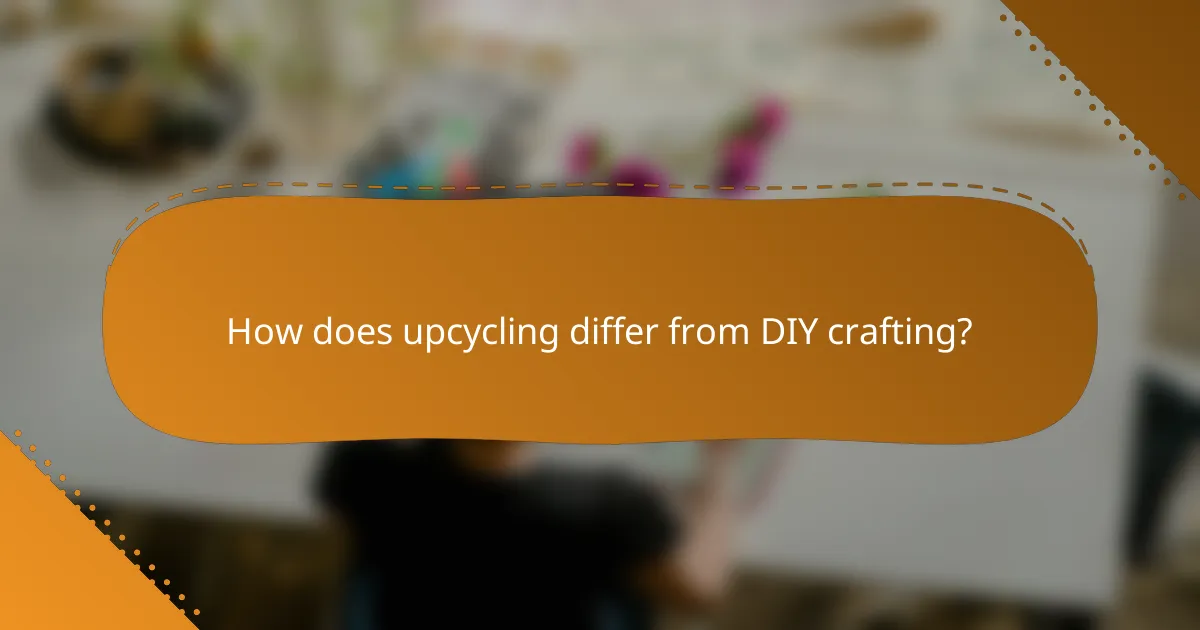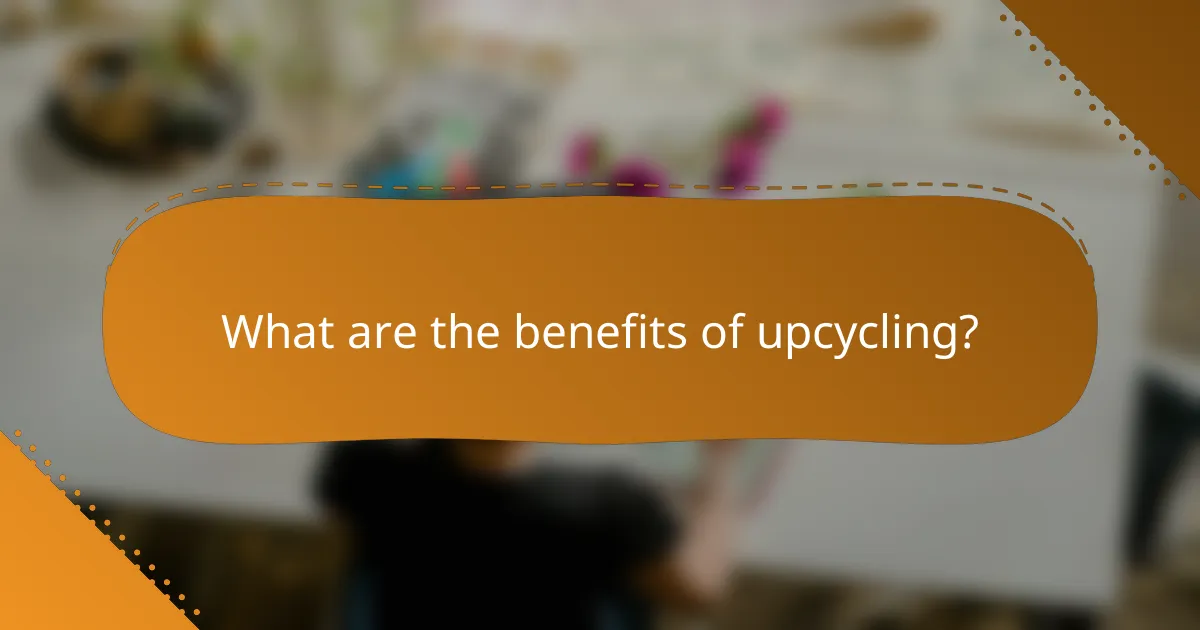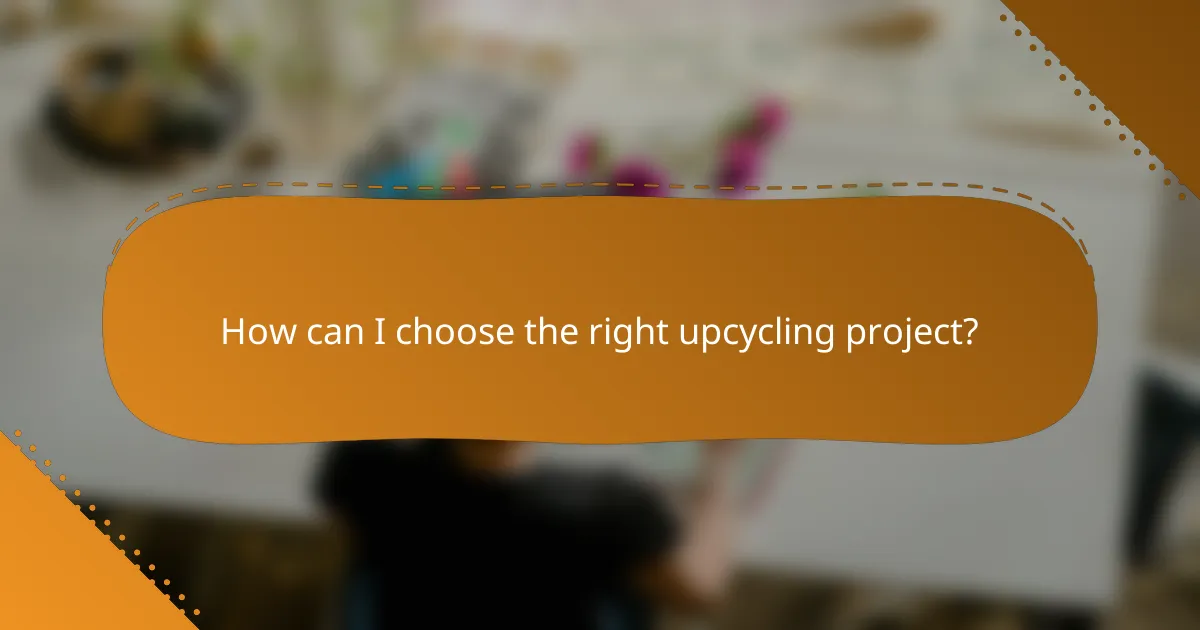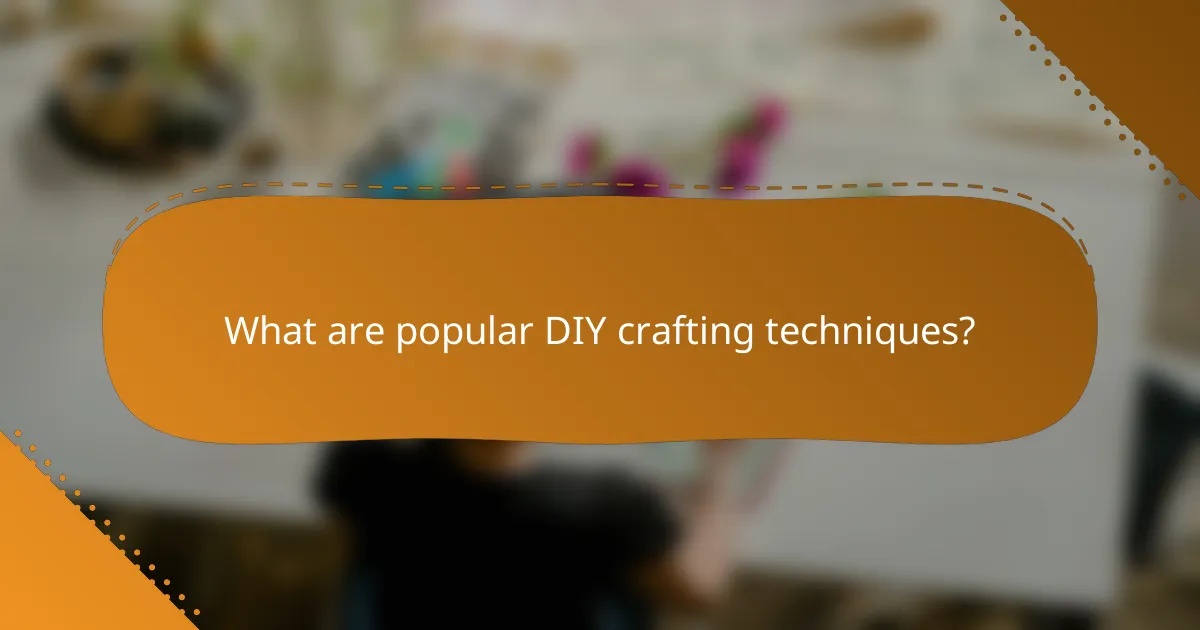Upcycling techniques provide a sustainable approach to home decor by creatively reusing materials to produce functional and visually appealing items. Unlike DIY crafting, which may involve new or repurposed materials without a focus on waste reduction, upcycling emphasizes transforming discarded items into new products, fostering both creativity and environmental responsibility.

What are effective upcycling techniques for home decor?
Effective upcycling techniques for home decor involve creatively reusing materials to create functional and aesthetically pleasing items. These methods not only reduce waste but also add a unique touch to your living space.
Furniture transformation
Furniture transformation involves taking old or discarded furniture and giving it a new life through refinishing, repainting, or reupholstering. For instance, a worn-out wooden chair can be sanded down and stained, while an outdated sofa can be reupholstered with modern fabric. Consider the cost of materials versus the value added to ensure a worthwhile project.
When transforming furniture, always check for structural integrity before starting. A simple checklist includes inspecting joints, ensuring stability, and assessing the condition of the finish. This ensures that your upcycled piece is both beautiful and functional.
Fabric repurposing
Fabric repurposing involves using old textiles to create new home decor items, such as throw pillows, curtains, or quilts. For example, you can turn a vintage tablecloth into decorative pillow covers or use old jeans to make a patchwork quilt. This technique allows for creativity while minimizing waste.
When working with fabric, consider the weight and durability of the material. Lightweight fabrics are great for curtains, while heavier fabrics work well for upholstery. Always pre-wash fabrics to prevent shrinkage after the project is complete.
Glass jar crafts
Glass jar crafts utilize empty jars to create decorative storage solutions or lighting fixtures. You can paint jars for a colorful display, use them as candle holders, or even turn them into terrariums. This method is cost-effective and can add a rustic charm to your decor.
To enhance your glass jar projects, consider adding embellishments like twine, lace, or paint. Ensure that any paint used is suitable for glass surfaces, and if using jars for food storage, make sure they are properly cleaned and sanitized.
Wood pallet projects
Wood pallet projects involve disassembling pallets to create furniture or decor items, such as coffee tables, garden planters, or wall art. Pallets are often free or low-cost, making them an economical choice for upcycling. However, ensure that the pallets are safe for indoor use, as some may have been treated with chemicals.
When working with pallets, use a pry bar for disassembly and sand the wood to avoid splinters. A simple project could be creating a pallet coffee table by stacking and securing pallets together, then adding a glass top for a polished finish.
Old clothing redesign
Old clothing redesign involves altering or repurposing garments into new items, such as bags, quilts, or home decor. For instance, a pair of old jeans can be transformed into a stylish tote bag. This technique not only breathes new life into clothing but also allows for personal expression.
When redesigning clothing, consider the fabric type and the intended use of the new item. Use a sewing machine for durability, and don’t forget to incorporate embellishments like buttons or patches for added character. Always wash and iron the clothing before starting your project to ensure the best results.

How does upcycling differ from DIY crafting?
Upcycling focuses on transforming waste materials into new products, while DIY crafting typically involves creating items from new or repurposed materials. The key difference lies in the intent to reduce waste in upcycling, whereas DIY crafting may not prioritize sustainability.
Focus on waste reduction
Upcycling is primarily driven by the goal of waste reduction. It takes discarded items, such as old furniture or clothing, and creatively repurposes them into functional or artistic pieces. This process not only diverts waste from landfills but also encourages a more sustainable lifestyle.
In contrast, DIY crafting may not emphasize waste reduction. Crafters often use new materials or pre-purchased supplies to create their projects. While some DIY projects can be eco-friendly, the focus is usually on creativity and personal expression rather than minimizing environmental impact.
Material sourcing differences
Upcycling relies heavily on sourcing materials from waste streams, such as thrift stores, garage sales, or even items found at home. This approach often leads to unique creations, as the materials used can vary widely in shape, size, and condition.
DIY crafting generally involves purchasing materials from craft stores or online retailers. Crafters might select specific items for their projects, which can lead to more uniformity in the final product. However, this can also increase costs, as new supplies can add up quickly.
Skill level comparison
Upcycling can require a diverse skill set, as it often involves problem-solving and creativity to transform materials into new forms. Skills such as sewing, woodworking, or painting may be necessary, depending on the project.
DIY crafting can range from simple to complex, making it accessible for various skill levels. Beginners can start with straightforward projects using basic materials, while more experienced crafters can tackle intricate designs. Regardless of skill level, both upcycling and DIY crafting offer opportunities for learning and personal growth.

What are the benefits of upcycling?
Upcycling offers numerous advantages, including reducing waste and creating functional or artistic items from discarded materials. This practice not only benefits the environment but also encourages creativity and resourcefulness.
Environmental impact
Upcycling significantly reduces the amount of waste sent to landfills by repurposing items that would otherwise be discarded. This process conserves natural resources and minimizes pollution associated with manufacturing new products.
By choosing to upcycle, individuals can contribute to a circular economy, where materials are reused rather than disposed of. This shift helps decrease the demand for new raw materials, which often involves environmentally harmful extraction processes.
Cost savings
One of the main benefits of upcycling is the potential for cost savings. By using materials you already have, you can create new items without spending money on new supplies. This can be particularly beneficial for those on a tight budget.
For example, transforming old furniture or clothing can save you hundreds of dollars compared to purchasing new items. Additionally, upcycled products often have a unique charm that can fetch a higher price if sold, providing an opportunity for extra income.
Unique creations
Upcycling allows for the creation of one-of-a-kind items that reflect personal style and creativity. Each project can be tailored to individual tastes, resulting in unique pieces that stand out from mass-produced goods.
Whether it’s turning glass jars into decorative storage or repurposing wooden pallets into furniture, the possibilities are endless. This uniqueness not only enhances personal spaces but can also serve as conversation starters or gifts that carry a personal touch.

What tools are essential for upcycling projects?
Essential tools for upcycling projects include a mix of hand tools, power tools, and crafting supplies. Having the right equipment can significantly enhance your efficiency and creativity in transforming old items into new treasures.
Basic hand tools
Basic hand tools are fundamental for any upcycling project. Common tools include screwdrivers, pliers, hammers, and utility knives. These tools allow you to disassemble, reshape, and repair materials easily.
Consider investing in a good-quality set of hand tools that can handle various tasks. For instance, a versatile screwdriver set can save time when working with different fasteners. Always keep your tools organized to streamline your workflow.
Power tools
Power tools can greatly expand your capabilities in upcycling. Essential power tools include drills, saws, and sanders. These tools help you cut, shape, and finish materials more efficiently than hand tools alone.
When selecting power tools, consider your project’s scale and complexity. For example, a cordless drill is handy for quick tasks, while a jigsaw is ideal for intricate cuts. Always prioritize safety by using protective gear and following manufacturer guidelines.
Crafting supplies
Crafting supplies are crucial for adding the finishing touches to your upcycled projects. Items such as paint, glue, fabric, and decorative elements can transform a basic piece into a unique creation. Choose supplies that complement the materials you are working with.
Keep a well-stocked crafting kit with essentials like paintbrushes, adhesives, and embellishments. This will allow you to experiment freely and make adjustments as needed. Be mindful of the drying times and compatibility of different materials to achieve the best results.

How can I choose the right upcycling project?
Choosing the right upcycling project involves assessing your available materials, considering your skill level, and evaluating the time you can commit. By aligning these factors with your interests, you can select a project that is both enjoyable and feasible.
Assess available materials
Start by taking inventory of the materials you already have at home. Common items for upcycling include old furniture, glass jars, fabric scraps, and cardboard boxes. Knowing what you have can inspire creative ideas and help you avoid unnecessary purchases.
Consider the condition and type of materials. For example, sturdy wooden pallets can be transformed into furniture, while glass bottles can become decorative vases. Prioritize projects that utilize materials you already own to minimize costs and waste.
Consider skill level
Your skill level plays a crucial role in selecting an upcycling project. If you are a beginner, opt for simpler projects like turning an old t-shirt into a tote bag. More advanced crafters might tackle furniture refinishing or complex sewing projects.
Be honest about your abilities and choose projects that challenge you without causing frustration. Online tutorials and community workshops can provide guidance and boost your confidence as you learn new techniques.
Evaluate time commitment
Assess how much time you can realistically dedicate to an upcycling project. Some projects can be completed in a few hours, while others may take several days or even weeks. For instance, a quick project like creating coasters from cork can be done in under an hour, while a full furniture makeover may require multiple sessions.
Consider your schedule and choose projects that fit within your available time. If you have limited time, break larger projects into smaller, manageable tasks to keep the process enjoyable and less overwhelming.

What are popular DIY crafting techniques?
Popular DIY crafting techniques include a variety of hands-on activities that allow individuals to create unique items using readily available materials. These techniques often emphasize creativity, personalization, and sustainability, making them appealing to crafters of all skill levels.
Knitting and crocheting
Knitting and crocheting are two of the most popular DIY crafting techniques that involve creating fabric from yarn. Knitting uses two needles to interlock loops of yarn, while crocheting employs a single hook to pull yarn through loops. Both methods can produce a wide range of items, from clothing to home decor.
When starting with knitting or crocheting, it’s essential to choose the right yarn and tools. Beginners often find that medium-weight yarn and standard-sized needles or hooks are easier to work with. Consider starting with simple projects like scarves or dishcloths to build confidence and skill.
Common pitfalls include not checking gauge, which can lead to items that are too large or small, and becoming frustrated with complex patterns. To avoid these issues, take your time, practice basic stitches, and gradually progress to more intricate designs. Joining local crafting groups or online communities can also provide support and inspiration.


